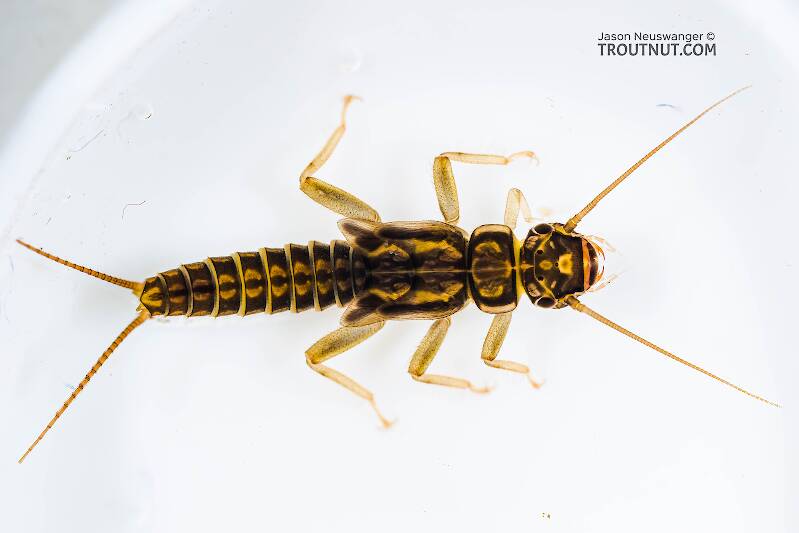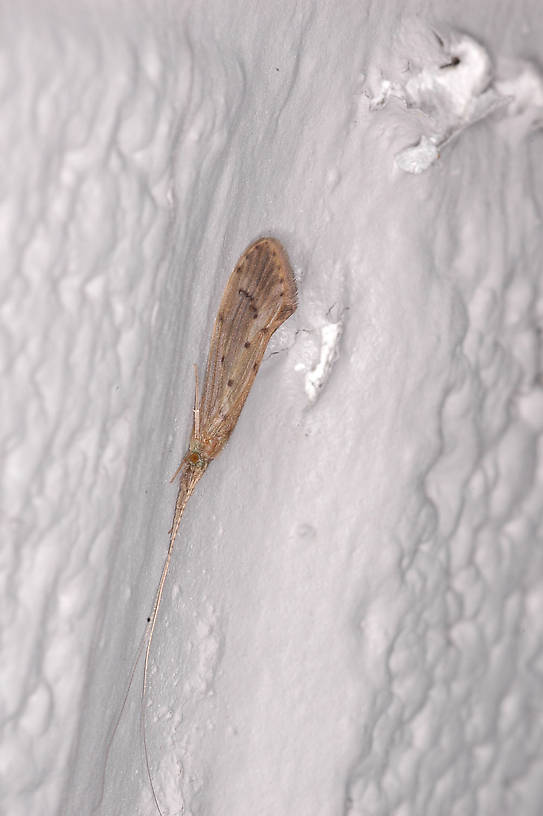
Hex Mayflies
Hexagenia limbata
The famous nocturnal Hex hatch of the Midwest (and a few other lucky locations) stirs to the surface mythically large brown trout that only touch streamers for the rest of the year.


Caddisfly Species Oecetis avara (Tan Spotted-Wing Long-Horned Sedges)
Where & when
This abundant species emerges in June in most places, or in mid- to late July at higher altitudes.In 125 records from GBIF, adults of this species have mostly been collected during June (24%), July (24%), August (21%), May (7%), April (7%), and September (6%).
In 71 records from GBIF, this species has been collected at elevations ranging from 259 to 8005 ft, with an average (median) of 2530 ft.
Species Range
Larva & pupa biology
Current speed: Prefers (but does not require) slow water
Shelter type: "Horn-shaped" sand cases
Identification
Species ID from GBIFthe Global Biodiversity Information Facility
Source: Review and redescription of species in the Oecetis avara group, with the description of 15 new species (Trichoptera, Leptoceridae)
Diagnosis. This species is similar to and most likely to be confused with Oecetis houghtoni sp. n., especially due to their sympatric distributions and relatively minor morphological differences. Unfortunately, the range of variation for the 2 species has not been fully established and specimens from some localities may not be currently diagnosable if they do not conform closely to the holotypes for the 2 species (see remarks section following the species description). The holotype of Oecetis avara is characterized by a very well developed ventral lobe of the inferior appendage that forms a prominent, acutely angled projection. The ventral margin is distinctly elongate (see Figs 11 - 14 for comparison to Oecetis houghtoni). Some evidence of " wrinkling " is apparent at the point of articulation between the dorsal and ventral lobes; this is distinctly more noticeable than in Oecetis houghtoni due to the sharper angle of articulation. Also, as compared to Oecetis houghtoni, the phallobase is usually more distinctly sclerotized and arched ventrally, with its apex strongly downturned and very finely striate, often with the extreme apex slightly ridged or burred. Unfortunately, characters of the phallobase are subtle and also variable within the 2 species and thus may not always be completely diagnostic. Although the holotype of Oecetis avara itself is grayish-brown in color, with forewings only weakly spotted (possibly as a result of the specimen being somewhat faded), specimens from most areas of its distribution, including those from Minnesota, are distinctly lighter in color than Oecetis houghtoni and also have more prominent forewing spots. In Minnesota, Oecetis avara can be distinguished from Oecetis houghtoni by color alone (Figs 40 and 41). Despite the close similarity and difficulty of distinguishing Oecetis avara from Oecetis houghtoni, another species that closely resembles Oecetis avara, both in color and genitalic aspects, is Oecetis verrucula sp. n. from Central America. The only significant difference is the possession of a small rugose wart or projection pre-apically on the phallobase in Oecetis verrucula, similar to the character state in Oecetis sordida, sp. n. This character is absent in Oecetis avara, but suggested by the fine striations often observed near the apex of the phallobase. COI barcode data (Fig. 58) also suggest that Oecetis avara and Oecetis verrucula are more closely related to each other than to Oecetis houghtoni. Rationale for treating Oecetis verrucula as a separate species is discussed in its diagnosis and description.
Specimens of the Caddisfly Species Oecetis avara
1 Adult
Start a Discussion of Oecetis avara
References
- LaFontaine, Gary. 1981. Caddisflies. The Lyons Press.
- Swisher, Doug and Carl Richards. 2000. Selective Trout. The Lyons Press.
Caddisfly Species Oecetis avara (Tan Spotted-Wing Long-Horned Sedges)
Species Range
Common Names
Resources
- NatureServe
- Integrated Taxonomic Information System
- Global Biodiversity Information Facility
- Described by Banks (1895)


